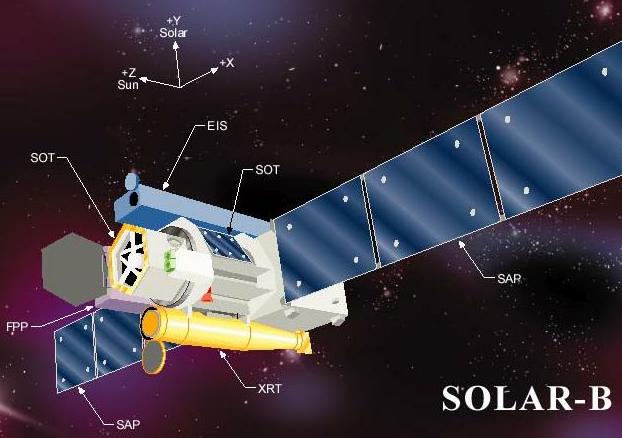The Mission
The Solar-B mission is an international collaboration between Japan, the United States, and the United Kingdom, and follows the successful Yohkoh (Solar-A) mission. Solar-B is scheduled to launch from Kagoshima, Japan in September 2006. It will ride an M-V rocket into a polar, Sun-synchronous orbit 600kilometers above the Earth's surface, where it will spend three years almost continously observing the Sun.
Solar-B's array of advanced optical, ultraviolet, and X-ray instruments will let us study solar structures and processes on very small scales and across a broad range of wavelengths. We will measure magnetic fields and electric currents in enough detail to understand the causes of eruptions in the solar atmosphere, and relate those eruptions to the intense heating of the corona and the mechanisms that drive the solar wind.

International Partners
Spacecraft Mission Management: Japan (JAXA) Solar Optical Telescope (SOT) Optical Telescope Assembly (OTA), instrument integration: Japan (JAXA) Focal Plane Package (FPP): Lockheed Martin Solar and Astrophysics Lab X-ray Telescrope (XRT) Telescope, filters, mechanisms, and instrument integration: Smithsonian Astrophysical Observatory (SAO) Camera and electronics: Japan (JAXA) Extreme Ultraviolet Imaging Spectrometer (EIS) Optics and mechanisms: U.S. Naval Research Laboratory (NRL) Structure, camera, electronics, and instrument integration: United Kingdom (PPARC)
Spacecraft
Optical telescope: 0.5-meter diameter primary mirror Mass: 875 kg Power: 500 W (two single-axis solar arrays) Telemetry: 5Mbps for 10 minute playback Data Recorder: 3 Gbit (solid state) Attitude: solar-pointed reaction control subsystem (RCS) Stability: 0.02 arcseconds over 10s